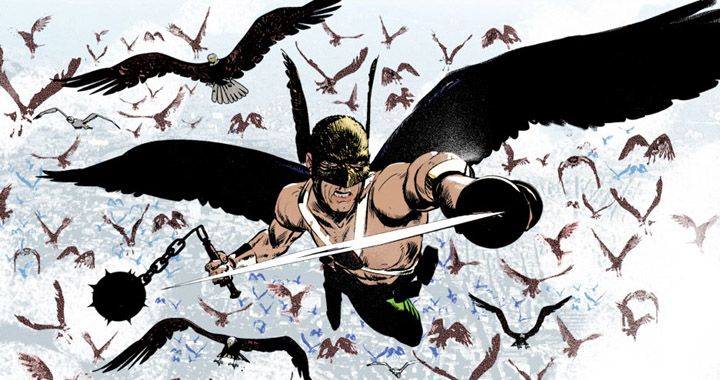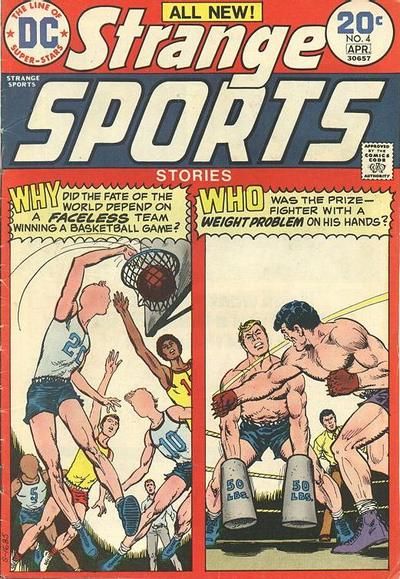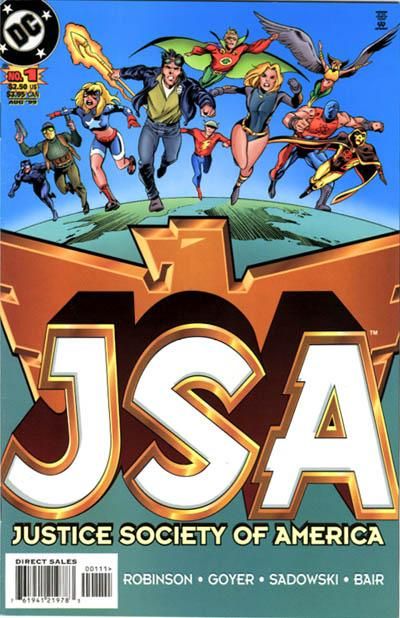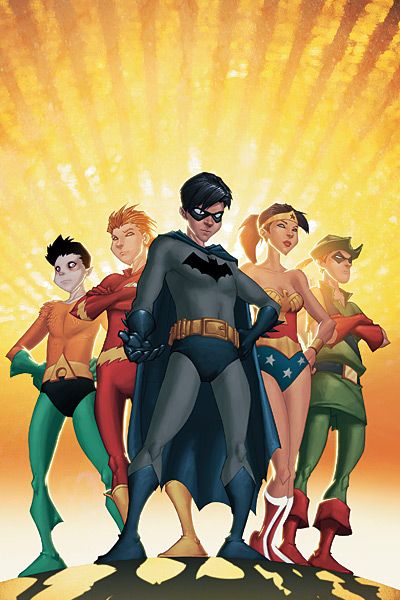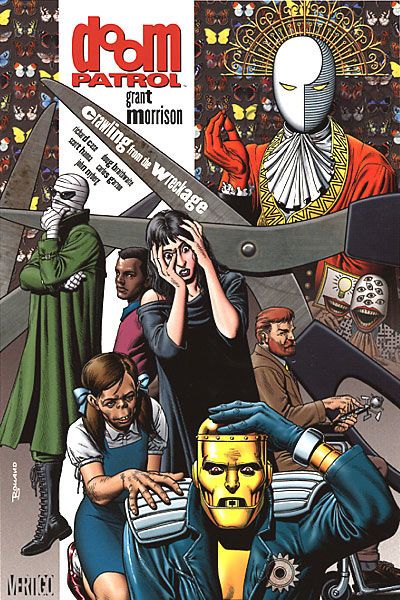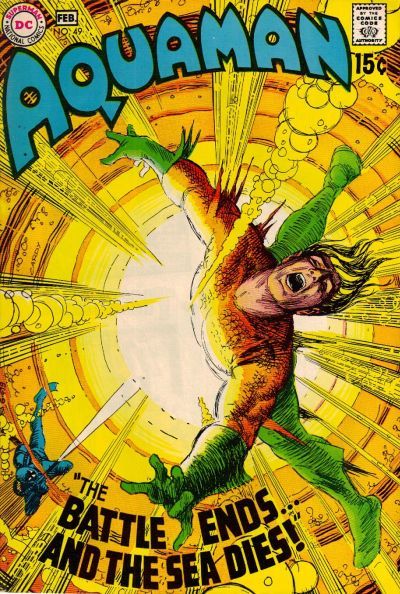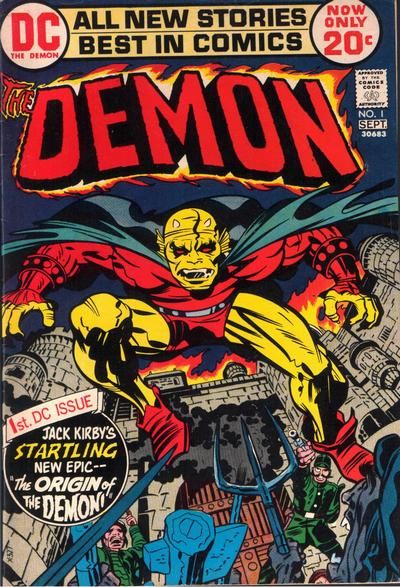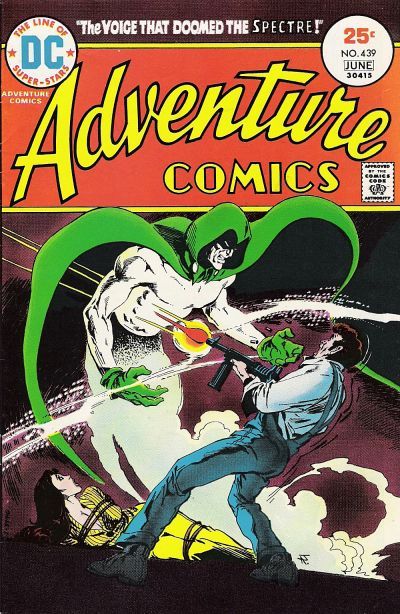Every March, college basketball fans carefully study the NCAA brackets to see which teams have the best chance of making the Final Four. Every year, certain teams seem like locks, and this year won’t be much different. The high seeds will include perennial powerhouses like Kansas, Kentucky, Syracuse, and Duke on the men’s side; and Connecticut and Tennessee on the women’s. The lowest seeds are, inevitably, those teams who are satisfied just to be included (fingers crossed for William & Mary -- they’re so close!). That leaves the vast middle populated by a number of familiar names: Old Dominion, Winthrop, San Diego State, Siena, et al. You’re never surprised to see them, but they don’t make it every year. However, every now and then one of these teams becomes more of a fixture; and nowadays fans would probably be surprised if Gonzaga or Butler failed to make the tournament.
Naturally, comparing DC’s superhero line to the field of 65 isn’t especially precise; but there is the notion that a title or character can shake off that Cinderella status and become a perennial player in the Big Dance. DC has been working pretty steadily towards making its characters more “familiar” to the general public, and to a certain extent that means putting familiar favorites in its lineup. With that in mind, let’s examine the staying power of some venerable DC books and separate some pretenders from contenders.
* * *
Justice Society of America is a good example. For a little over ten years, the JSA appeared in All Star Comics #s 3-57 (Winter 1940-February/March 1951), until it fell victim to superhero comics’ first great extinction. Over the next twelve years, though, the JSA went from being a relic of the Golden Age to an annual Silver Age tradition. Brought back in the pages of The Flash #137 (June 1963), the JSA first teamed up with their Earth-One counterparts two months later, in Justice League of America #21 (August 1963). The team-ups continued through 1985, and gave the Justice Society annual exposure.
No doubt this contributed to the JSA’s own mid-‘70s feature, which headlined a revived All Star Comics. Picking up with issue #58 (January/February 1976), it lasted until issue #74 (September/October 1978). From there the JSA moved into Adventure Comics, albeit for only six issues (#s 461-66, January/February 1979-November/December 1979).
Nevertheless, DC wasn’t done with the Justice Society. A little less than two years later (cover date September 1981) it launched the WWII-era All Star Squadron. A-SS wasn’t quite a JSA title, although many JSAers appeared in it; but it’s probably close enough for our purposes. Furthermore, it spun off Infinity, Inc., a team of present-day next-generation superheroes. All Star Squadron lasted 67 issues (until March 1987) and Infinity lasted 53 (March 1984-August 1988). Because the reality-altering Crisis On Infinite Earths hit the Earth-2 books pretty much where they lived, All Star Squadron was followed by the new-continuity-friendly Young All-Stars. It ran 31 issues (June 1987-November 1989).
By this time, though, DC basically was done with the Justice Society. Indeed, in 1986 it published the Last Days Of The Justice Society Special, in which most of the familiar JSAers were packed off to another dimension. They’d never die, but they also wouldn’t be interacting with the rest of DC-Earth. Thus, when Infinity stopped chronicling the youngsters in 1988, and Young All-Stars wrapped up its wartime tales in 1989, the prospects of a Justice Society revival looked dim.
Well, maybe not. 1991's retro-styled Justice Society of America miniseries (eight issues, April 1991-November 1991) led to a short-lived ongoing series, set in the present day (ten issues, August 1992-May 1993). Unfortunately, September 1994's Zero Hour killed off many of the original JSAers, apparently closing the book on the original super-team.
Again, though, not so fast -- because another legacy of Zero Hour was James Robinson and Tony Harris’ popular Starman series, whose frequent references to the Golden Age arguably laid the groundwork for the Justice Society’s return. After the surviving JSAers teamed up with the Justice League (JLA #28-31, April-July 1999), the new team began coming together in August 1999's JSA Secret Files and JSA #1. Written initially by James Robinson and David Goyer, then-newcomer Geoff Johns took over early on and stayed with JSA pretty much through the end of its initial run (issues #1-87, August 1999-September 2006). The book went on a brief Infinite Crisis-related hiatus before its relaunch as the current Justice Society of America (February 2007). These titles have also produced spinoffs, namely JSA Classified (issues #1-39, September 2005-August 2008) and the current JSA All-Stars (February 2010-present).
Admittedly, sales of Justice Society have slipped significantly since Johns left, such that some now wonder why DC is publishing a second JSA title. Still, the Justice Society now enjoys over ten years of fairly-continuous publication. While that’s something it’s never before had, the earlier 1976-89 period of revivals, anthology features, and alternate takes shows a similar reader interest.
Compare the JSA’s history with that of the Teen Titans, another team book with Silver Age Justice League connections. It too had a brief 1970s revival, but after the runaway success of Marv Wolfman and George Pérez’s New Teen Titans in the early 1980s, its publication history has been a lot less fragmented. The original run ended after fifteen years (and two volumes) with New Titans #130, December 1995. From there an entirely new group of Teen Titans had the spotlight for two years (#s 1-24, October 1996-September 1998), but many of them were brought into the larger Titans fold by Devin Grayson and Phil Jiminez’ 1998 JLA/Titans miniseries (December 1998-January 1999). Around that time, the Titans books essentially split along generational lines, with the fourth-generation sidekicks forming Young Justice (56 issues, September 1998-May 2003) and the older folks going into an adjectiveless Titans series (50 issues, March 1999-April 2003). These books were then relaunched in 2003, with most of Young Justice (and some older Titans) going into the current Teen Titans series, and a few of the older Titans forming a new group of Outsiders. To me, the current Titans book has basically taken the place of that Outsiders title (although there’s now another Outsiders, to confuse the issue further) -- but with most of the Titans now in the Justice League, Titans itself is about to have a radical makeover.
The upshot is that both Justice Society and Teen Titans have become fixtures on DC’s schedule, but the latter has had an easier time staying there. In fact, neither Teen Titans nor Titans have been critical favorites for a while, and neither is a particularly strong seller. (To be fair, neither is a particularly bad seller.) It’s the kind of circumstance which suggests that there will always be an audience for these titles, so DC might as well publish them, even if the Titans book features a lot of unrelated supervillains.
Somewhere in between is the Doom Patrol. Under creators Arnold Drake and Bruno Premiani, the DP lasted over four years (My Greatest Adventure #80 through Doom Patrol #121, May 1964-September/October 1968) before being killed in their book’s final issue. You’d think that would put a damper on revivals, and for the most part you’d be right. Almost nine years passed before a rebuilt Robotman joined three (mostly) new characters in the New Doom Patrol (Showcase #s 94-96, August/September 1977-December/January 1978). This group made occasional guest appearances around the DC line for the next few years.
Probably one of the more memorable guest-shots was the Doom Patrol homage in New Teen Titans vol. 1 #s 13-15 (November 1981-January 1982). Robotman, Mento, and Beast Boy/Changeling were the only Patrollers participating, but the spirits of their late colleagues hung heavy over the Titans’ battles with Madame Rouge, General Zahl, and the Brotherhood of Evil. I’ve often thought that the Teen Titans connection helped get the next Doom Patrol revival off the ground, but Doom Patrol vol. 2 #1 didn’t appear until cover-date October 1987. By one measure it wasn’t especially successful, lasting only eighteen issues before being semi-canceled (and killing much of the team in the process). However, DC only took the book out of its newsstand line, and the direct-sales-only Doom Patrol #19 appeared the next month with a new team of characters, guided by the new creative team of Grant Morrison and Richard Case. They all stayed until issue #63, and the book continued (under writer Rachel Pollack) until issue #87 (February 1995).
That run of seven-plus years was followed by an almost-seven-year drought before Doom Patrol was revived once again by writer John Arcudi and artist Tan Eng Huat. DP vol. 3 lasted 22 issues (December 2001-September 2003), but barely a year passed before John Byrne launched the controversial Vol. 4. Byrne treated the original Doom Patrol as entirely new characters, thereby ignoring all their previous appearances. Fans didn’t like it, but it still lasted 18 issues (August 2004-January 2006). The time-twisting effects of Infinite Crisis and an explanatory appearance in Teen Titans tried to straighten everything out, so that now the original Patrollers are all alive, and their histories are (mostly) intact. Accordingly, we’re now on Vol. 5 (August 2009-present), written by Keith Giffen and penciled by Matthew Clark.
I don’t know that the Doom Patrol’s longevity is self-perpetuating like the Titans. I suspect it’s more of the “let’s take a stab at a decent idea” school of thought, which may help explain the various Justice Society revivals.
* * *
That’s all fine for those current series, but what about titles which might be on the bubble? Aquaman will have a spot on DC’s dance card at least as part of Brightest Day, but the character seemed ripe for a revival pretty soon after the last regular Aquaman series ended.
Aquaman’s Silver Age streak was pretty solid, from August 1955's Adventure Comics #215 (August 1955) to March/April 1971's Aquaman vol. 1 #56. The Sea King lasted for almost six years in Adventure (to #282, March 1961) and followed that with short stints in Showcase (#30-33, January/February 1961-July/August 1961) and Detective Comics (#s 293-300, July 1961-February 1962) before getting his own series in January/February 1962. After a hiatus of about three-and-a-half years, another couple of stints in Adventure (#435-37, 441-52, September/October 1974-July/August 1977) led into his own series (#s 57-63, August/September 1977-August/September 1978). When Aquaman was canceled again (as part of the “DC Implosion,” I think), he went back to Adventure for a couple of years (#s 460-78, November/December 1978-December 1980), then to a rotating backup in Action Comics (#s 517-21, 527-30, 536-40, March 1981-February 1983).
For most of this period, of course, Aquaman appeared fairly frequently in Justice League of America, so it was probably pretty natural for him to head up the no-outside-interests “Detroit League.” Although domestic troubles eventually made him give up the League, he was pretty prominent in the book for about a year and a half (#s 228-43, July 1984-October 1985).
Aquaman then appeared in a series of miniseries and specials, including 1986's 4-issue Neal Pozner/Craig Hamilton miniseries, 1988's “Missing Peace” special, Keith Giffen and Curt Swan’s 5-issue revised origin (1989), and Peter David and Esteban Maroto’s 7-issue 1990 Atlantis Chronicles (which, for obvious reasons, focused more on Aquaman’s ancestors). Another ongoing series followed (13 issues, December 1991-December 1992), overlapping slightly with Aquaman’s involvement in Justice League Europe (issues #37-50, April 1992-May 1993). Peter David returned to the character with another revised origin, 1993's Time And Tide miniseries (4 issues, December 1993-February 1994), followed six months later by another ongoing series (77 issues, August 1994-January 2001). Aquaman was apparently killed as part of 2001's “Our Worlds At War” crossover, but it looked pretty dubious at the time. Sure enough, the “Obsidian Age” storyline (JLA #s 70-76, Late October 2002-February 2003) got him ready for the most recent Aquaman ongoing (#1 was cover-dated February 2003). This series saw the original Aquaman, Arthur Curry/Orin of Atlantis, succeeded by one Arthur Joseph Curry; and the book became Aquaman: Sword Of Atlantis for what would be its final eighteen issues (#s 40-57, May 2006-December 2007). Along the way, Orin died, and has been seen most recently as part of the Black Lantern Corps (although a mysterious “Aquaman” had a cameo in Final Crisis).
It’s been a couple of years since Sword of Atlantis ended, but Aquaman remains one of those characters who never strays too far from DC’s consciousness. The promise of his involvement in Brightest Day seems like part of the same trend, and fits pretty neatly with DC’s practice of promoting its characters’ most familiar versions. I’d be surprised not to see a new Aquaman feature spinning out of Brightest Day, and I expect DC to promote the heck out of whatever involvement Geoff Johns has with it.
Also thanks to the Black Lanterns, Aquaman’s JLA teammate Hawkman has been fairly visible in Blackest Night. (One imagines his and Hawkgirl’s story would be continued similarly in Brightest Day.) The Silver Age Hawkman enjoyed a solid run in the 1960s, from initial appearances in The Brave and the Bold #s 34-36 and 42-44 (February/March 1961-October/November 1962) to a six-year run which included Mystery In Space #s 87-91 (November 1963-May 1964), Hawkman vol. 1 #s 1-27 (April/May 1964-August/September 1968), and Atom and Hawkman #s 39-45 (October/November 1968-October/November 1969).
Justice League appearances notwithstanding, though, the Winged Warrior had to wait some nine years for his own feature, this time in World’s Finest Comics (issues #253, 256-59, 262, 264-70, and 272-82; October/November 1978-August 1982). After that it was about three years before the Shadow War Of Hawkman miniseries (4 issues, May-August 1985) 1986's follow-up Hawkman Special, and the subsequent Hawkman ongoing series (17 issues, August 1986-December 1987).
And then ... well, DC decided to get creative with Hawkman, mucking about with his history in 1989's three-issue Hawkworld miniseries. Hawkworld naturally became an ongoing series (32 issues, June 1990-March 1993) and together with its Hawkman relaunch (34 issues, September 1993-July 1996), lasted over six years. On its merits the series (written by John Ostrander and William Messner-Loebs) were probably pretty decent. However, continuity tangles frustrated professionals and readers alike, and for the next few years Hawkman was quietly ignored.
Enter Geoff Johns, once again, cutting this particular Gordian knot in JSA #s 22-26 (May-September 2001) in preparation for the most recent Hawkman ongoing series. It starred Hawkman from issues #1-49 (May 2002-April 2006) and switched to Hawkgirl for the rest of its run (May 2006-September 2007). As fate would have it, though, Jim Starlin produced 2008's Hawkman Special, in which readers learned that yes, everything they know is wrong.
I am considerably more pessimistic about another Hawkman revival. For one thing, it looks like DC wanted to kill Hawkman and Hawkgirl back in Final Crisis. For another, considering Hawkman’s convoluted history, I cannot for the life of me fathom why DC would want to throw in another twist. Surely Hawkman’s publishing history does not indicate that readers have the patience to keep up with all these changes. Kyle Baker produced a very entertaining Hawkman strip for Wednesday Comics, but that had the advantage of being relatively short and focusing on how Hawkman could fly and hit things real hard. That bare-bones approach may not carry over well into a regular ongoing series. Therefore, apart from more frequent appearances in Justice Society and/or Justice League, I’d say that for the moment, Hawkman’s bubble has burst.
There is never any particular push to reinvent or update the Demon, and the larger DC line doesn’t seem to require his continued presence. Accordingly, his publication history depends more on the whims of particular creative people than on editorial dictates.
The original Jack Kirby series ran for sixteen issues (August/September 1972-January 1974) and was followed by a series of backups in Batman Family (#17, April/May 1978) and Detective Comics (#s 482-85, February/March 1979-August/September 1979). Following the occasional guest spot in books like Wonder Woman, Swamp Thing, and Blue Devil, next up was Matt Wagner’s miniseries (four issues, January-April 1987). After that were 1988's Cosmic Odyssey miniseries, an Action Comics Weekly arc (issues #636-41, January 24, 1989-March 7, 1989) and a Detective Comics guest-shot. The latter was written by Alan Grant, who with artist Val Semeiks produced Etrigan’s second ongoing series (59 issues, July 1990-May 1995) soon afterwards. However, aside from a couple more Batman team-ups and other assorted appearances, it was eight-and-a-half years between the end of that series and the Demon: Driven Out miniseries (six issues by Josh Dysart and Pop Mhan, November 2003-April 2004). John Byrne and Will Pfeifer’s Blood of the Demon ongoing series followed that (nine issues, May 2005-January 2006), and the character has appeared subsequently with Catwoman in Wednesday Comics. Thus, Etrigan hasn’t really established himself as a perennial part of DC’s schedule, and I doubt fans are expecting to see him there in any given month. If he were a basketball team, he’d probably be happy with the NIT.
Finally, let’s look at the Spectre, a Golden Age hero whose modern interpretations have focused more on his religious aspects. The Spectre has been part of a few recent Big Events, including 2005's Day Of Vengeance miniseries which led into Infinite Crisis, 2008's Final Crisis: Revelations miniseries, and the current Blackest Night. DC acts like it wants to do a lot with him, so let’s see what it’s actually done.
The Spectre’s original adventures were in More Fun Comics #s 52-101 (February 1940-January/February 1945). He was also a member of the Justice Society in both the Golden and Silver Ages. In the late ‘60s he appeared solo in Showcase #s 60-61 and 64 (January/February-September/October 1966) and a year later received his own short-lived title (ten issues, November/December 1967-May/June 1969). The mid-‘70s saw the well-known Michael Fleisher/Jim Aparo Adventure Comics series (#s 431-40, January/February 1974-July/August 1975), followed up in a three-issue Dr. 13 arc in Ghosts (#s 97-99, February-April 1981).
The ‘80s, ‘90s, and ‘00s each had their own ongoing Spectre series. The first, written by Doug Moench, ran 31 issues (April 1987-November 1989); the second, written by John Ostrander and drawn by Tom Mandrake, ran 63 (December 1992-February 1998); and the third, written by J.M. DeMatteis and featuring the Hal Jordan Spectre, ran 27 (March 2001-May 2003). That last series was prefaced by both the Day Of Judgment big-event miniseries (5 issues, November 1999) and a transitory arc in Legends of the DC Universe (#s 33-36, October 2000-January 2001). Therefore, except for three years around the beginning of the ‘90s and eighteen months towards the end, the Spectre was on DC’s schedule pretty regularly for over sixteen years (1987-2003).
It didn’t stop there. After Hal went back to being Green Lantern in 2004, detective Crispus Allen got the call in 2005's Infinite Crisis. Crispus/Spectre then starred in 2006's Crisis Aftermath: The Spectre miniseries (3 issues, July-September 2006). That was followed almost immediately by an arc in Tales of the Unexpected (8 issues, December 2006-July 2007) and roles in Countdown To Mystery’s Eclipso arc (8 issues, November 2007-June 2008) and the aforementioned Revelations miniseries (5 issues, October 2008-February 2009). Certainly DC has found ways to use the character for much of the past twenty-two years.
Nevertheless, I’m not sure that either Hal/Spectre or Crispus/Spectre ever really caught on with readers. Of course, many readers probably preferred Hal as Green Lantern, and many might have wondered why DC killed Crispus instead of simply creating a new character. Still, barring some special underpinnings for the character coming out of Blackest Night, I’d say the Spectre’s frequent spots on DC’s schedule are coming to a close. These days the Spectre looks like a team with a decent seed which, for whatever reason, exits the tournament prematurely. Believe me, I’ve rooted for plenty of teams like that -- and I have all the Hal Jordan Spectre issues to prove it ...
* * *
In the end, though, the more a publisher falls back on familiar standbys -- even familiar standbys given radical makeovers -- the more conservative that publisher becomes. Presently, DC’s superhero lineup is pretty wide-ranging, and includes a lot of those familiar features. If, as mentioned above, DC intends to go more conservative now so that it can expand with new titles later, that’s fine. Brief interruptions notwithstanding, DC will never stop publishing Action, Detective, Batman, Superman, Wonder Woman, The Flash, Green Lantern, or Justice League, because they make up the publisher’s superhero foundation. The books we’ve talked about today aren’t quite on that A-list, but they each have some degree of dependability which keeps landing them on DC’s schedule.
However, like March Madness, part of the fun of superhero comics is unpredictability. It leads to the joy of discovery and the chance to see the familiar through new eyes. I didn’t expect to like “Architecture & Mortality” more than the Spectre stories in Tales of the Unexpected, but I ended up looking forward to each “A&M” installment a lot more. Since the Green Lanterns and Kentuckys will always be around, and the Aquamans and Wake Forests will have their days, what’s really special is watching the mid-majors elbow their way into the upper reaches.
(That probably makes Deadpool this year’s George Mason, but thankfully this isn’t the Marvel column ...)

